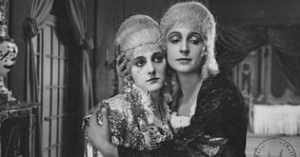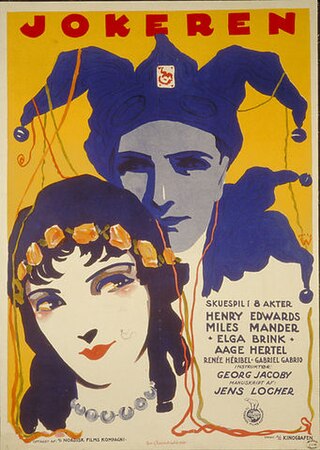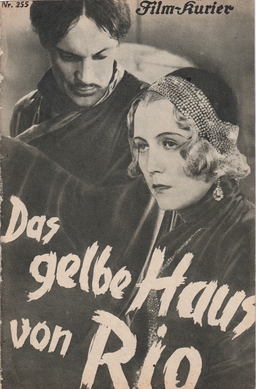
Maria the Maid is a 1936 German drama film directed by Veit Harlan and starring Hilde Körber, Hilde Hildebrand, and Alfred Abel. It is based upon Die Kindsmagd, a novella by Walter Harlan. It was shot at the Johannisthal Studios in Berlin. The film's sets were designed by the art directors Erich Grave and Hans Minzloff.
The Woman in Heaven is a 1920 German silent film directed by Johannes Guter and starring Lil Dagover and Werner Krauss.

Thieves on Strike is a 1921 German silent film directed by Alfred Abel.

Lotte Lore is a 1921 German historical film directed by Franz Eckstein and starring Erna Morena, Alfred Abel, and Margarete Schlegel.
Comrades is a 1919 German silent film directed by Johannes Guter. It is based on the play Marauders by August Strindberg.

Three Around Edith is a 1929 German silent crime film directed by Erich Waschneck and starring Camilla Horn, Jack Trevor and Gustav Diessl. It was shot at the National Studios in Berlin. The film's sets were designed by the art director Alfred Junge.

The Joker is a 1928 Danish-German silent drama film directed by Georg Jacoby and starring Henry Edwards, Elga Brink, Miles Mander and Renée Héribel. It is based upon the 1927 play The Joker by Noel Scott. The film was also released under the German language title Der Faschingskönig.
Who Invented Divorce? is a 1928 German silent film directed by Wolfgang Neff and starring Alfred Abel, Hans Albers and Caleb Glenn.

Ariadne in Hoppegarten is a 1928 German silent sports film directed by Robert Dinesen and starring Alfred Abel, Maria Jacobini and Paul Henckels. It takes place in Hoppegarten, a traditional centre of horseracing in the German capital of Berlin.
Den of Iniquity is a 1925 German silent film directed by Constantin J. David and starring Reinhold Schünzel, Jack Trevor and Maly Delschaft.
The Bank Crash of Unter den Linden is a 1926 German silent film directed by Paul Merzbach and starring Alfred Abel, Hans Albers, and Margarete Schlegel. It was produced by the German subsidiary of the Fox Film Company.

The Five Accursed Gentlemen is a 1932 French mystery drama film directed by Julien Duvivier and starring Anton Walbrook, Camilla Horn and Jack Trevor. It was made as the German-language version of Moon Over Morocco.
The Vice of Gambling is a 1923 German silent film directed by Dimitri Buchowetzki and starring Alfred Abel, Willy Kaiser-Heyl, and Theodor Loos.
The Silent Mill or The Story of the Silent Mill is a 1914 German silent drama film directed by Richard Oswald and starring Alfred Abel, Ferdinand Bonn and Robert Valberg.
The Vice is a 1915 German silent drama film directed by Richard Oswald and starring Alfred Abel, Rosa Valetti and Arthur Wellin.
The Black Count is a 1920 German silent film directed by Otz Tollen and starring Olga Engl, Alfred Abel, and Rudolf Klein-Rogge.
The Terror of the Red Mill is a 1921 German silent film directed by Carl Boese and starring Aud Egede-Nissen, Otto Gebühr, and Alfred Abel.
The Game of Love is a 1924 German silent film directed by Guido Parish and starring Marcella Albani, Alfred Abel, and Carl de Vogt.
Tragedy of a Marriage is a 1927 German silent drama film directed by Maurice Elvey and starring Isobel Elsom, Alfred Abel and Paul Richter. It is also known by the alternative title of Human Law. It is still extant.

The Yellow House of Rio or The Yellow House of King-Fu is a 1931 French-German crime thriller film directed by Karl Grune and starring Charlotte Susa, Gustav Diessl and Karl Günther. The film was based on a novel of the same title by Josef M. Velter. It was shot at the Joinville Studios of Pathé in a co-production with Bavaria Film. The film's sets were designed by the art directors Otto Erdmann and Hans Sohnle. Separate German French-language versions were produced, the latter directed by Grune and Robert Péguy and featuring Renée Héribel and Charles Vanel. The German version was originally also planned to be released as The Yellow House of Rio, but to avoid confusion with another film released at the same time Road to Rio, it was retitled.








